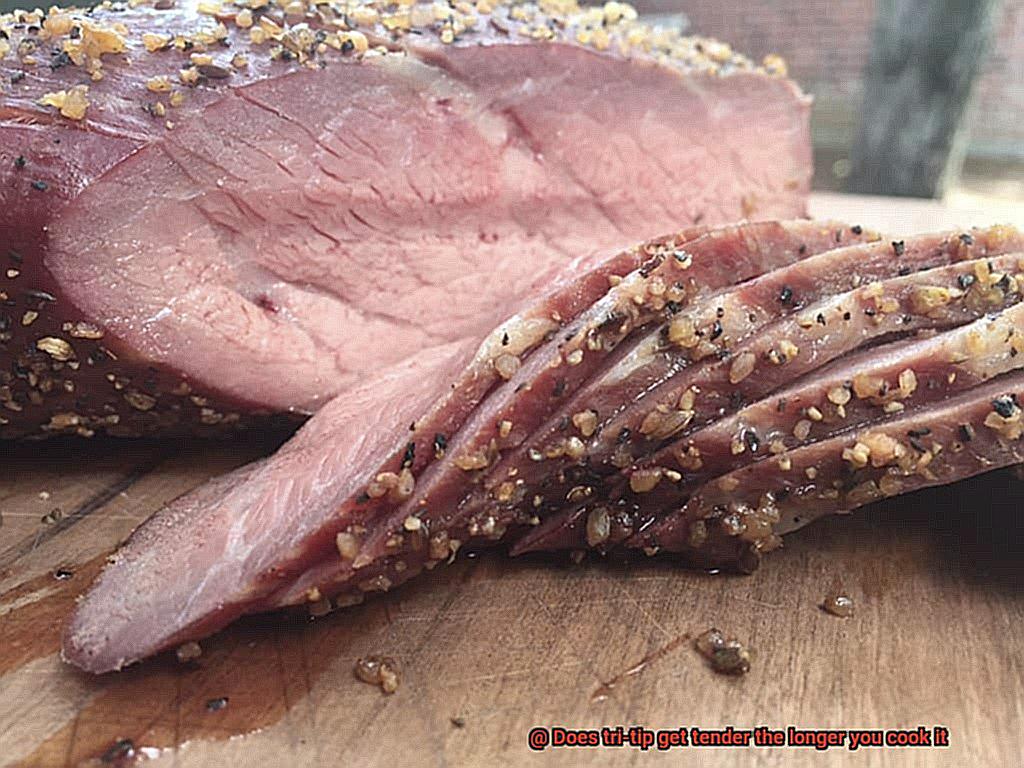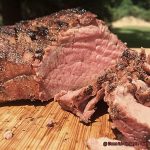Are you a self-proclaimed steak connoisseur who’s always on the hunt for the perfect cut of beef? Look no further than tri-tip steak – a popular choice that has earned its place as a household staple across the nation.
But, there’s one question that has sparked an ongoing debate among meat enthusiasts: Does tri-tip get tender the longer you cook it? Some swear by slow-cooking for hours, while others argue that quick searing is key to achieving a juicy and flavorful result.
In this blog post, we’ll explore the science behind cooking tri-tip and finally put this age-old question to rest. We’ll delve into crucial factors such as cooking temperature, timing, and cut quality to help you achieve mouthwatering results every time – regardless of your preferred cooking method.
So, if you’re ready to elevate your steak game and become a true tri-tip master, keep reading. We’ve got all the tips and tricks you need to know about this beloved cut of beef.
Contents
Understanding the Cut of Meat: What Makes Tri-Tip Different?
This unique cut of beef hails from the hindquarters of the cow and is known for its lean, triangular shape. While tri-tip is a staple in California and other parts of the western United States, it remains relatively unknown in other regions.
So, what makes tri-tip different from other cuts of beef? For starters, its grain runs in two different directions, which can make cooking it evenly a bit challenging. Additionally, tri-tip is relatively low in fat content, making it a healthy option but also increasing the risk of it drying out during cooking.
But fear not. With proper cooking techniques, tri-tip can be delicious and tender. One way to achieve this is by marinating the meat for several hours before cooking. This helps break down the muscle fibers and infuse additional flavor into the meat. Slow-cooking at a lower temperature can also help retain moisture and prevent the meat from becoming dry and tough.
In conclusion, understanding the unique characteristics of tri-tip is key to achieving a tender texture and flavorful steak. To summarize:
- Tri-tip has a unique grain that runs in two different directions
- It is relatively low in fat content
- Marinating for several hours before cooking can help break down muscle fibers and add flavor
- Slow-cooking at a lower temperature can help retain moisture
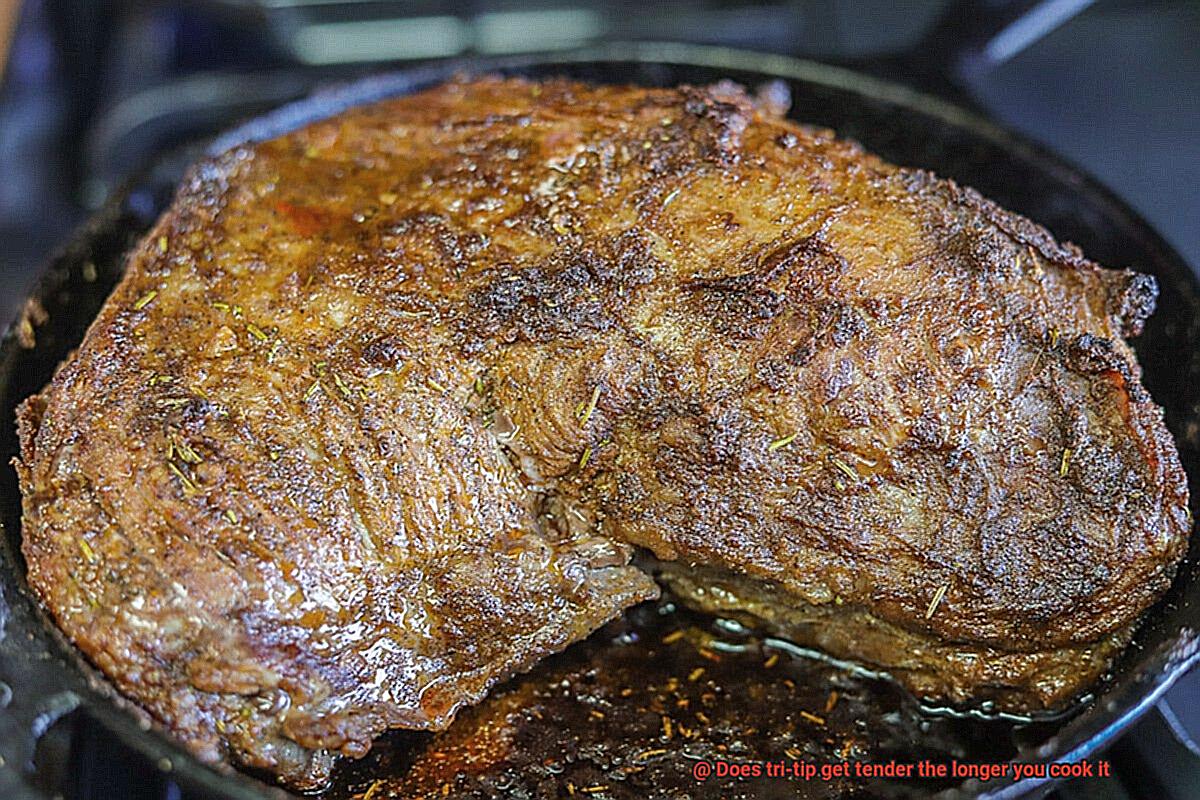
Does Tri-Tip Get Tender the Longer You Cook It?
As a connoisseur of beef cuts, I’m often asked if tri-tip gets more tender with longer cooking times. The truth is that while this may seem like a good idea, it can actually ruin the flavor and texture of the meat. Tri-tip is a lean cut of beef that comes from the bottom of the sirloin, and it’s known for its rich flavor and tender texture. It’s best cooked to medium-rare or medium doneness, with an internal temperature of 130-135 degrees Fahrenheit.
But why doesn’t tri-tip get more tender with longer cooking times? There are a few reasons for this:
Tri-tip is a lean cut of beef with less fat marbling than other cuts. While this makes it a healthier option, it also means that it can dry out quickly if overcooked.
The grain direction of tri-tip can make it challenging to cook evenly, resulting in some parts being undercooked while others are overdone.
Cooking tri-tip for too long can cause the proteins in the meat to tighten up, making it tough and chewy.
So how can you ensure that your tri-tip stays tender and juicy? Here are some tips:
- Use a meat thermometer to monitor the temperature closely as you cook.
- Marinate your tri-tip before cooking to infuse it with flavor and help tenderize the meat.
- Let your tri-tip rest after cooking to allow the juices to redistribute.
- Slice your tri-tip thinly against the grain to help break down any tougher fibers.
Factors That Affect How Tender Tri-Tip Becomes
Tri-tip is a beloved cut of beef that comes from the bottom sirloin region and is prized for its rich flavor and affordability. However, achieving the perfect level of tenderness can be a bit tricky. Luckily, as an expert on this topic, I’m here to give you the scoop on the factors that affect how tender tri-tip becomes.
First up is the cooking method. While grilling is a popular choice due to its direct heat and quick cook time, it can result in tough and chewy meat if not done correctly. On the other hand, smoking requires more time but allows for a slow-cooking process that breaks down the connective tissue, resulting in tender and juicy meat.
Temperature is another crucial factor to consider. Cooking tri-tip at high temperatures can cause it to become dry and tough, while low temperatures can result in a tender and flavorful cut. To achieve the perfect internal temperature, aim for 135-140°F for medium-rare or 145°F for medium.
Marbling also plays a significant role in tenderness. The more marbling a cut of meat has, the more tender and flavorful it will be when cooked. Thankfully, tri-tip has moderate marbling, making it an excellent choice for grilling or smoking.
Lastly, let’s talk about thickness. A thicker cut will require more cooking time to reach the desired internal temperature, which can potentially lead to a tougher texture if not cooked properly. To ensure optimal tenderness, slice your tri-tip against the grain to help break down any remaining connective tissue.
Tips on How to Make Tri-Tip More Tender
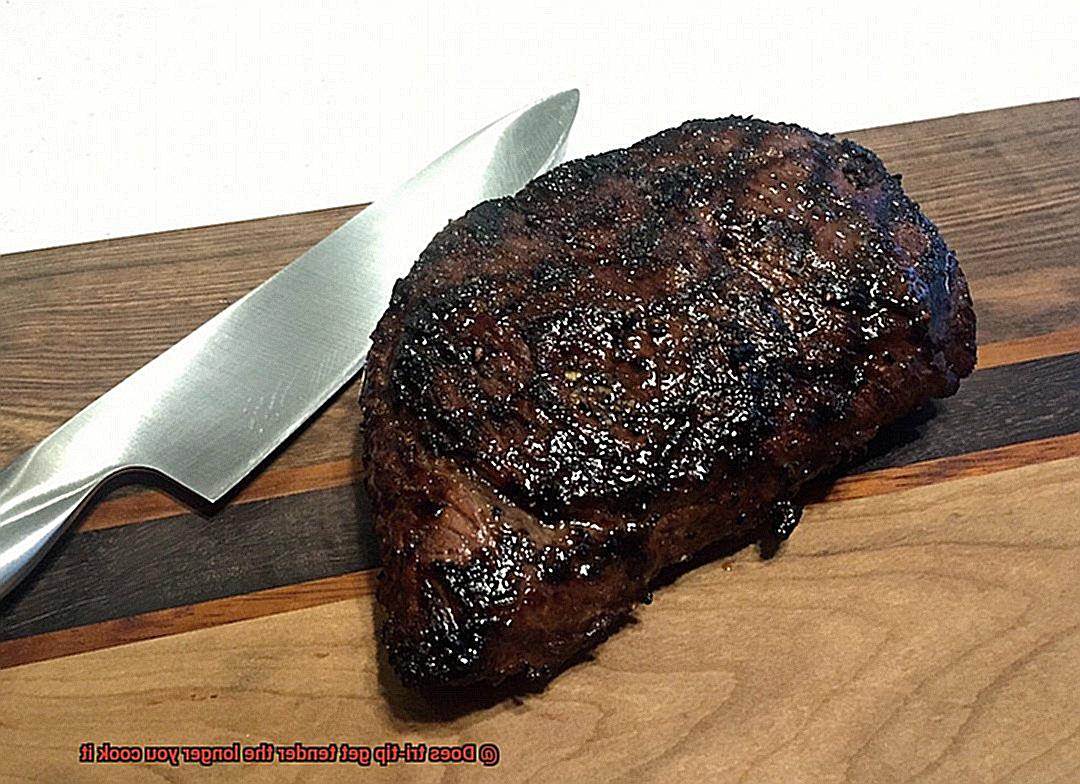
Tri-tip is a mouth-watering cut of beef that can be tough to chew if not cooked properly. However, there are several tips and tricks to make it more tender and enjoyable to eat. Here are five sub-sections that explain how to prepare tender tri-tip.
Marinating
Marinating your tri-tip can help break down tough muscle fibers and add flavor. A marinade usually comprises acidic ingredients like vinegar or lemon juice, oil, herbs, and spices. The acid in the marinade helps to break down the muscle fibers, making the meat more tender. To marinate your tri-tip, place it in a plastic bag, pour the marinade over it, and refrigerate for at least 4 hours or overnight.
Slow cooking
Another way to prepare tender tri-tip is by slow-cooking it for several hours in a crockpot or oven. This method allows the meat to cook at a low temperature, which breaks down the collagen and makes it more tender. For slow-cooking, season your tri-tip with your preferred spices and place it in the crockpot or oven for 6-8 hours until it reaches the desired internal temperature.
Resting
After cooking your tri-tip, allow it to rest for at least 10-15 minutes before slicing into it. This allows the juices to redistribute throughout the meat, resulting in a more tender and flavorful final product. Cover your tri-tip loosely with foil while resting to keep it warm.
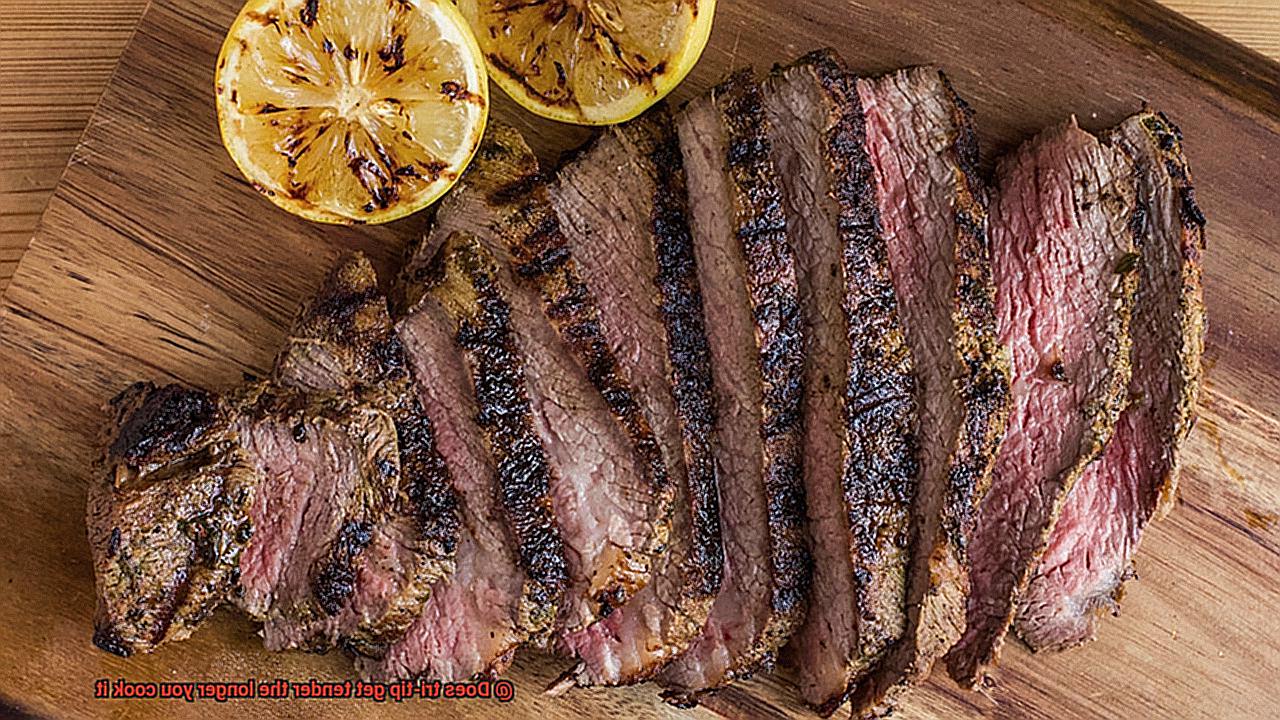
Slicing
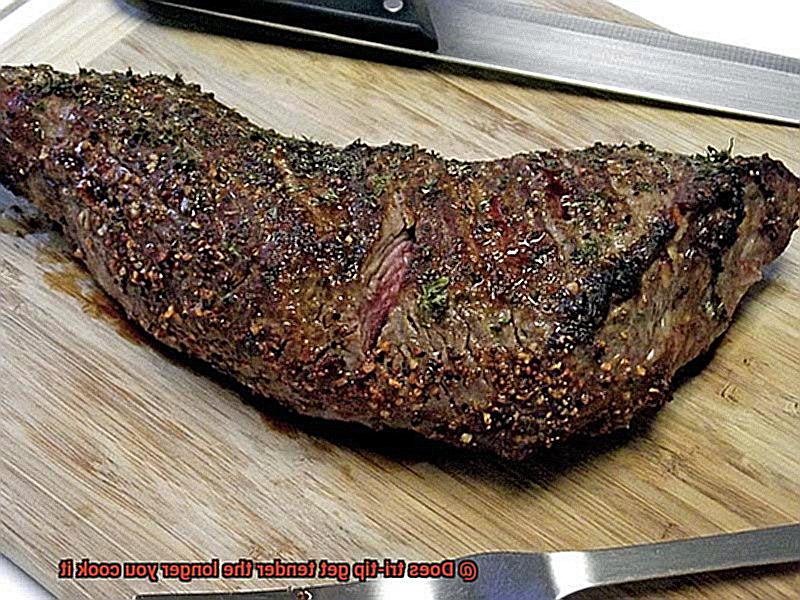
When you’re ready to slice your tri-tip, be sure to cut against the grain. This means cutting perpendicular to the direction of the muscle fibers. Cutting against the grain shortens the fibers and creates a more tender texture. Slice your tri-tip into thin slices, about ¼ inch thick, for maximum tenderness.
Pounding
If you’re short on time or forgot to marinate your tri-tip, you can pound it to make it more tender. Use a meat mallet to pound the meat on both sides to break down the muscle fibers and create a more tender texture. Be sure not to overdo it, or you may end up with shredded meat.
The Benefits of Marinating Tri-Tip Before Cooking
Look no further than marinating. As a culinary expert, I can tell you that the benefits of marinating tri-tip before cooking are endless.
Firstly, marinating adds moisture to the meat, preventing it from drying out during cooking. This is especially important for lean cuts like tri-tip. The acid in the marinade helps to break down the proteins in the meat, making it more tender and juicy. Plus, the added moisture can help reduce cooking time as well.
But that’s not all – marinating allows for a diverse range of flavors to be infused into the meat. From sweet and tangy to spicy and savory, the possibilities are endless. You can get creative with your marinade ingredients and experiment until you find your perfect flavor profile.
Here are some popular ingredients to consider when making a marinade:
- Citrus juice (lemon, lime, or orange)
- Soy sauce
- Worcestershire sauce
- Olive oil
- Garlic
- Ginger
- Honey
- Brown sugar
- Chili powder
Marinating is also a great way to tenderize tougher cuts of meat like tri-tip. By soaking it in a flavorful mixture before cooking, the meat becomes more tender and enjoyable to eat.
Incorporating marinating into your cooking routine is easy and effective. Simply mix together your desired ingredients, let the tri-tip soak for a few hours or overnight, then cook as desired. With so many marinade recipes available online or in cookbooks, you’ll never run out of options.
Slow Cooking as an Option for Making Tri-Tip More Tender
Slow cooking is a magical method that can transform even the toughest cuts of meat into juicy, fork-tender delights.
As an expert on this topic, I can tell you that slow cooking is a tried-and-true method for making tri-tip more tender. This technique involves cooking the meat at a low temperature for an extended period, allowing the connective tissue to break down and the meat to become more tender. But what are the different methods for slow cooking tri-tip?
First up is oven cooking. To get started, preheat your oven to 275°F. Season your tri-tip with salt, pepper, and any other desired seasonings, then place it in a roasting pan with a rack. Add some liquid to the pan, such as beef broth or red wine. Cover the pan with foil and bake for about 3-4 hours until it’s fork-tender.
If stovetop cooking is more your style, heat a heavy-bottomed pot over medium-high heat. Season your tri-tip and sear it on all sides until it’s beautifully browned. Add some liquid to the pot and bring it to a simmer. Then reduce the heat to low and cover with a lid. Cook for about 3-4 hours until it’s tender.
Finally, using a slow cooker is perhaps the easiest method for slow cooking tri-tip. Simply season your meat and place it in the slow cooker with some liquid. Cover and cook on low for about 6-8 hours until it’s fork-tender.
Not only is slow cooking convenient because it requires minimal effort – you can just set it and forget it until it’s time to eat – but it’s also an excellent way to ensure that your tri-tip comes out perfectly every time. However, keep in mind that overcooking can result in meat that’s too soft or mushy. So be sure to monitor the temperature and doneness of the meat throughout the cooking process to ensure that it’s cooked to your liking.
Other Ways to Ensure Your Tri-tip is Moist and Delicious
When it comes to tri-tip, cooking time is just one aspect of ensuring a tender and juicy result. Here are five other ways to make sure your tri-tip is moist and delicious:
Marinating Your Meat
A marinade can do wonders for breaking down tough muscle fibers and adding flavor to your tri-tip. Try a simple marinade made with olive oil, vinegar, soy sauce, garlic, and herbs. Marinate your meat for several hours before cooking to ensure maximum tenderness.
Using a Meat Thermometer
Overcooking your tri-tip is a surefire way to end up with dry and tough meat. To prevent this, use a meat thermometer to monitor the internal temperature while cooking. Aim for 135°F for medium-rare and remove from heat source immediately. Let it rest for at least 10 minutes before slicing.
Resting Your Meat
Resting your tri-tip after cooking is crucial for letting the juices redistribute throughout the meat instead of spilling out when you cut into it. Cover your cooked tri-tip with foil and let it rest for at least 10 minutes before slicing. This helps keep the meat juicy and flavorful.
Slicing Against The Grain
Cutting against the grain breaks up the muscle fibers in your tri-tip, making each bite more tender. Before slicing, take note of the direction of the grain and cut perpendicular to it. This simple step can make a big difference in the tenderness of your meat.
Choosing High-Quality Meat
Lastly, choosing high-quality meat from a reputable source can make all the difference in the tenderness and flavor of your tri-tip. Look for cuts that are well-marbled with fat as this will help keep the meat moist during cooking. Quality meat will also have an overall better taste.
Common Mistakes to Avoid When Cooking Tri-tip
Let’s dive in.
Firstly, overcooking the tri-tip is a big mistake. While a longer cooking time can break down some of the connective tissues and make it more tender, there’s a fine line between tender and dry. A meat thermometer is your best friend here, ensuring that you hit the desired temperature without going overboard.
Secondly, seasoning is key. Tri-tip is already flavorful, but adding a good seasoning rub or marinade can elevate it to a whole new level. A few hours of marinating can also help to break down the connective tissues and add even more tenderness.
Proper resting is also crucial. Letting the cooked tri-tip rest for at least 10 minutes before slicing allows the juices to redistribute throughout the meat, resulting in a more tender and juicy final product.
When it comes to cooking temperature, be careful not to use excessively high heat. Searing the meat over high heat is great for getting that caramelized crust, but finishing it off over lower heat will ensure even cooking throughout.
Lastly, don’t forget to slice against the grain for maximum tenderness. The grain refers to the direction of muscle fibers in the meat, and slicing against it will result in shorter muscle fibers, making it easier to chew.
In summary, avoid these common mistakes when cooking tri-tip and your meat will turn out tender, juicy, and full of flavor every time. To recap:
- Don’t overcook
- Season well
- Rest properly
- Be mindful of cooking temperature
- Slice against the grain
c5BByAO1wn0″ >
Conclusion
In summary, tri-tip steak is a delicious and flavorful cut of beef that can be cooked to perfection with the right techniques. Despite the ongoing debate on whether it gets tender the longer you cook it, overcooking tri-tip will only result in dry and tough meat. To achieve a mouthwatering result, one must take into account the unique characteristics of this lean cut of beef.
To enhance tenderness and flavor, marinating for several hours before cooking is recommended. This not only breaks down muscle fibers but also infuses diverse flavors into the meat. Slow-cooking at a lower temperature is another method to retain moisture and achieve a juicy texture. Additionally, pounding or using a crockpot can further improve tenderness.
When cooking tri-tip, it’s crucial to avoid common mistakes such as overcooking, seasoning properly, resting adequately after cooking, being mindful of cooking temperature, and slicing against the grain for maximum tenderness. By following these tips and tricks, anyone can become a true tri-tip master.
So next time you’re preparing this beloved cut of beef, remember that tenderizing is not about how long you cook it but rather about understanding its unique characteristics and applying proper techniques.

